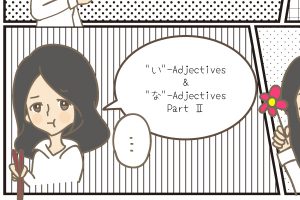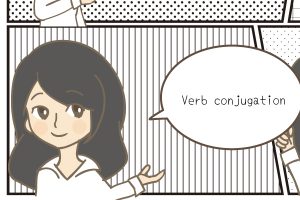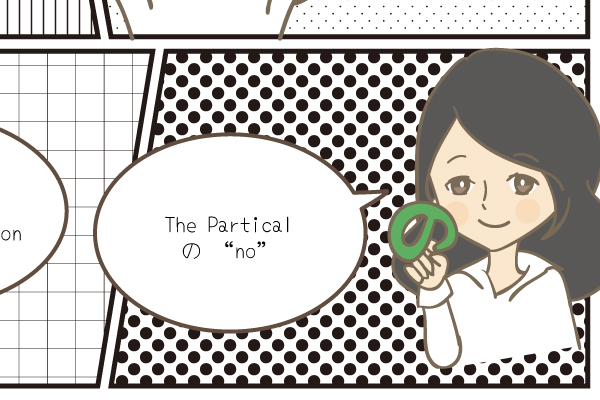Introduction to using the particle “の”
Last time you learned the basics about Japanese adjectives. This week Shiho took a look at the genitive particle “の” with which you can express possession and belonging using two nouns. Of course, there are other ways than “noun の noun” to use this particle, but let’s start with the basics!
| Table of Contents [Combining two nouns with “の”] [Word order when using “の”] [Can I use “の” with anything other than two nouns?] [Exercise] [Advanced: “の” as equalizer] |
[Combining two nouns with “の”]
Particles are part of the foundation of Japanese grammar and they come with many uses and in many forms. Hence, even advanced students can make mistakes when using them. Especially the particle “の” can easily be used incorrectly, despite its simplicity – or maybe exactly because of it!
The basic structure of expressing possession or belonging using “の” between two nouns works as follows:
名詞①+の+名詞②
Noun 1 + の + Noun 2
In this example Noun 1, which is followed directly by the particle “の”, is the possessor or place of belonging, while Noun 2 is the possessed or belonging one. Let’s look at some example sentences:
| 私の車。 | My car. |
| 会社の車。 | The company’s car. |
| トヨタの車。 | A car by Toyota. |
| 彼の車。 | His car. |
| 未来の車。 | A car from the future. |
As you can see, “の” always expresses possession or belonging. We are using the words “possession” and “belonging” because the nuance of “の” may change slightly depending on the context. So in the example of “会社の車”, the meaning of “の” can simply be translated to “the company’s car” – the question being “Who’s car?” and the possession being clear.
However, in the example of “トヨタの車”, the question is not simply “Who’s car?”, but rather: “Who constructed this car?” – hence the translation being more along the lines of “A car by Toyota”.
Another example showing this is “未来の車” – this would not be simply translated as “The future’s car”, but it means “A car from the future”. Therefore it is expressing not the possession of the future over the car, but the fact that the car belongs to the future in a less fixed way.
[Word order when using “の”]
The word order when making a genitive-construct as is done with the particle “の” may be slightly different in Japanese than in your mother tongue. Again, the correct word order is as follows:
名詞①+の+名詞②
Noun 1 + の + Noun 2
In this example, let’s say noun 1 is “A” and noun 2 is “B”. Then, “A” (noun 1) explains or gives context to “B” (noun 2). Therefore you always place the possessor/explainer in front of “の”, and the noun being described or “possessed” behind “の”.
In many other languages, this order is the other way around or interchangeable. In Japanese, when using the particle “の”, it must always be this word order.
This difference in word order becomes especially apparent when “の” is used not to express simple possession, but belonging. See this example and the English translation.
| ○○会社の社長。 | The president of ○○company. |
As you can see, the word order is switched in this example. Because of this, mixing up the word order when using “の” is very easy – and then the sentence quickly becomes completely confusing, so please keep the correct word order in mind when making sentences using the particle “の”.
Tip: Think of “の” like “‘s” in English. Directly translated it doesn’t make for pretty translations, but it will help keep the correct word order. E.g.:
| ○○会社の社長。 | ○○ company’s president. |
The translation may not be elegant, but it does help to get the word order right.
[adsense]
[Can I use “の” with anything other than two nouns?]
The answer is (generally) no. This is in fact a very easy mistake to make. Even lots of advanced students try to use “の” with adjectives. When using adjectives, remember the previous lessons – for “い”-adjectives, you do not need any word in between to connect them with nouns. For “な”-adjectives, you use “な”. Example:
| Wrong: 悲しいの夢 Correct: 悲しい夢 |
A sad dream |
| Wrong: 綺麗の花 Correct: 綺麗な花 |
A pretty flower |
[Exercise]
You can use the following sentence pieces to try and get the word order right! The solutions are further down.
① の/お昼ご飯/今日
② 髪/黒い/は/彼女/の/です
③ 店/美味しい/は/の/クッキー/あの
Solutions:
| ① 今日のお昼ご飯。 | Today’s lunch. |
| ② 彼女の髪は黒いです。 | That girl’s hair is black. |
| ③ あの店のクッキーは美味しい。 | The cookies at that shop are delicious. |
[Advanced: “の” as equalizer]
You have now learned how to combine two nouns with “の” to express a possession or belonging between these two nouns. One more advanced way to use “の” is to describe the relationship between two nouns using “の” as an equalizer. In this case, the structure is as follows:
名詞①=名詞②
Noun 1 = Noun 2
Examples:
| 社長の寺田さん。 | President Terada. |
| 友達ののようこさん。 | (My) friend Youko. |
Using “の” like this does not mean that “社長” owns “寺田さん” or that “寺田さん” belongs to “社長”, but it simply means that President = Terada. Terada “is” the president. Youko “is” my friend.
Please try using “の” a lot and practice getting the word order right!
| 助詞 | Particle |
| 上級者 | Advances student, advanced learner |
| 例文 | Example sentences |
| 紹介する | To introduce (something/somebody) |
| 所属 | Affiliation, belonging |
| 所有 | Possession, ownership |
| 同格 | The same rank, equality |
| 髪 | Hair |
| 間違い | Mistake |
| 順番 | Order (of things) |
| 母国語 | Mother tongue |
| 未来 | Future |
| 彼 | He |

Introduction to using adjectives in Japanese Part 2

How to conjugate verbs in Japanese Part Ⅰ


